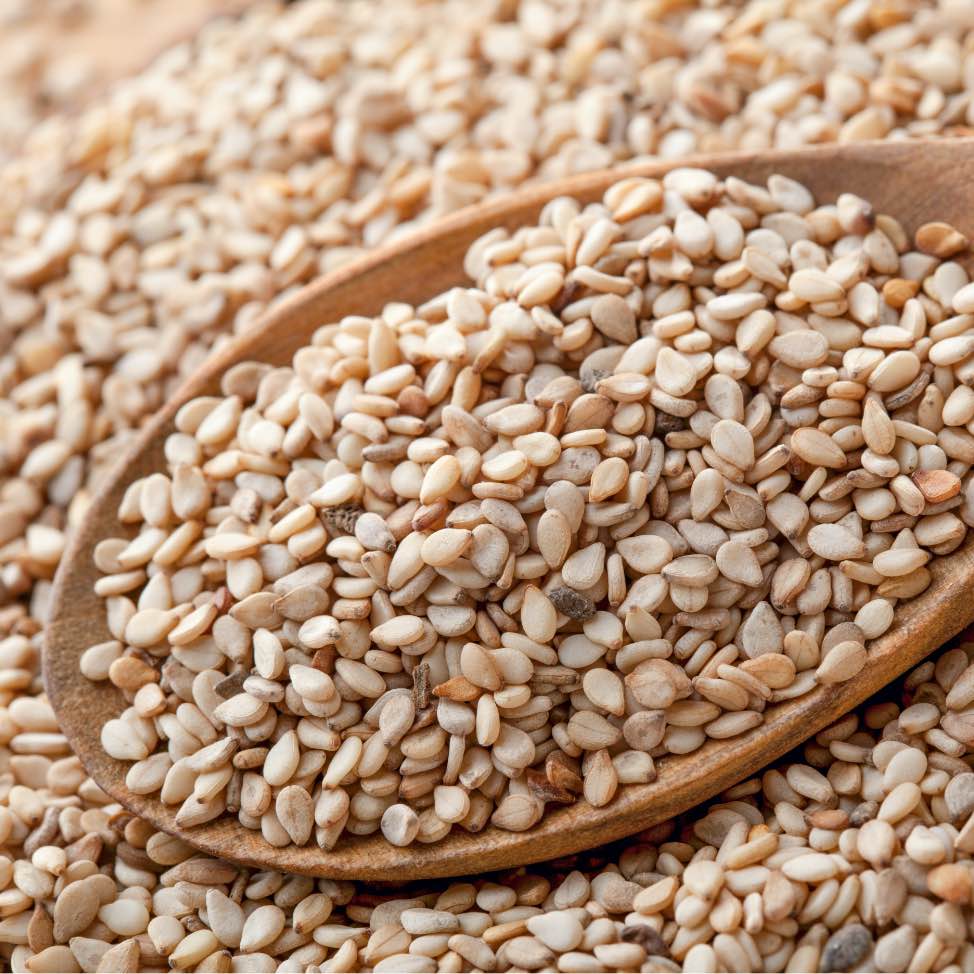Ethylene oxide in food and food additives
Findings of ethylene oxide (EtO) in sesame seeds and products made from sesame seeds have led to numerous complaints and product recalls in recent months. Extended investigations conducted by the monitoring authorities now show that many other raw botanical materials, ingredients and products made with these are contaminated with ethylene oxide.

RASFF: seeds, spices, herbs, food supplements and additives affected
These not only include food additive E410 locust bean gum (RASFF notification 2021.2966, 8 June 2021) and such spices as ginger (RASFF 2021.2552, 20 May 2021) and mustard seeds (RASFF 2021.4044), but also food supplements based on ginger extract (RASFF 2021.403, 30 July 2021), ashwagandha extract (RASFF 2021.3988, 28 July 2021) or moringa powder (RASFF 2021.3735, 14 July 2021).
(The Chemical and Veterinary Investigation Office (CVUA) in Stuttgart recently found excessive levels of ethylene oxide in numerous nutritional supplements. These appear to be attributable to the excipient hydroxypropyl methylcellulose (HPMC) E464 used in capsules and tablets (CVUA 2021).
Legal provisions
The use of ethylene oxide as a plant protection agent has been prohibited since 1981 in Germany and since 1991 in the EU. Maximum residue limits for ethylene oxide are laid down in Regulation (EC) No. 396/2005. The residue definition includes the sum of ethylene oxide and its metabolite 2-chloroethanol, expressed as ethylene oxide. According to Commission Implementing Regulation (EU) 2020/1540 of 22 October 2020, sesame seeds originating from India must be tested for the presence of ethylene oxide on importation. According to Article 19 of Regulation (EC) No. 396/2005, sesame seeds may not be processed or mixed if the maximum level of 0.05 mg/kg is exceeded.
Refer to the table for the limits imposed for other foodstuffs as laid down in Regulation (EC) No. 396/2005.

Table 1: Limit values and relevant matrices according to Regulation (EC) No. 396/2005
| Code Number | Groups and examples of individual products to which the MRLs apply (a) | Ethylene oxide (sum of ethylene oxide and 2-chloro-ethanol expressed as ethylene oxide) (F) Reg. (EU) 2015/868 Annex V |
|---|---|---|
| 0400000 | OILSEEDS AND OIL FRUITS e.g. sesame seeds | 0.05* |
| 0500000 | CEREALS e.g. oat | 0.02* |
| 0600000 | TEAS, COFFEE, HERBAL INFUSIONS, COCOA AND CAROBS | 0.1* |
| 0800000 | SPICES | 0.1* |
Ethylene oxide is also used as an excipient in the production of certain food additives. Regulation (EC) 231/2012 prescribes a maximum level of 0.2 mg/kg for these additives:
- Polyoxyethylene stearate (E431)
- Polysorbates (E432, E433, E434, E435, E436)
- Polyvinyl alcohol-polyethylene glycol graft copolymer (E1209)
- Polyethylene glycol (PEG) (E1521).
The regulation prohibits the use of ethylene oxide for sterilising purposes in food additives.
Findings that can be attributed to direct application must be evaluated as residues, whereas findings attributable to other causes may lead to an evaluation as contamination. Ethylene oxide is used to fumigate freight containers and warehouses in the international environment, for example, as well as stored goods, such as timber. Ethylene oxide remains stable in the atmosphere over a longer period of time under these conditions. Inadequate subsequent ventilation can lead to cross-contamination in the course of warehousing and transportation (EFSA 2012). Reliable, expeditious identification of the cause is frequently difficult in individual cases.
Risk assessment
Ethylene oxide is genotoxic and carcinogenic (IARC 2018). Although it is rapidly and completely metabolised to 2-chloroethanol to a great extent, 2-chloroethanol has also been classified as being mutagenic on the basis of animal studies although a final proof is pending. The residue definition therefore includes the metabolite 2-chloroethanol. The German Federal Institute for Risk Assessment (BfR) recently renewed its toxicological assessment of 2-chloroethanol in its updated health risk assessment of ethylene oxide residues, classifying ingredients and products with findings that are higher than the respective analytical detection limit as a health concern (BfR 2021).
Food monitoring measures and evaluation of organic products
In Germany, according to a notification issued by the Federal Ministry of Food and Agriculture (BMEL) dated 13 October 2020: "[…] in case of this maximum level (note: 0.05 mg/kg) being exceeded, sesame seeds and goods produced therewith must be taken off the market or recalled, resp. …" [BMEL 2020].
At EU level, in its expert opinion of 16 July 2021, the Member States Working Group of Food and Feed Crisis Coordinators stated that locust bean gum (flour) with EtO levels higher than the analytical determination limit (>0.1* ppm) and products made from it must be classified as unsafe food, as no safe level of exposure can be defined for ethylene oxide, due to its classification as genotoxic. This was precipitated by the detection of ethylene oxide in locust bean gum flour and ice cream produced with it (RASFF 2021.2966).
If there is substantiated evidence to show that the amount of ethylene oxide or 2-chloroethanol detected in organic sesame seeds or products is higher than the maximum level of 0.05 mg/kg (or other MRL/products accordingly), the seeds or products concerned must be withdrawn from the market. If levels lower than the applicable MRL are found, the organic status will be revoked if ethylene oxide, which is not permitted for organic products, has been actively used or inadequate precautions have been taken to prevent carry-over (refer to cross-contamination below).
The various EU Member States respond to findings in organic products in different ways, however. This means that while the organic status of a product is revoked if it is found to contain 0.01 mg/kg or more in most countries, there are some countries in which the level for revocation amounts to 0.02 mg/kg or more.
Analysis
PhytoLab has been testing raw botanical materials and products for the presence of ethylene oxide residues for many years now. These include dried herbs, spices, sesame seeds, other seeds and essential oils, as well as processed products, such as muesli.
The procedure adopted at PhytoLab permits the prescribed determination of free ethylene oxide and 2-chloroethanol, as well as the optional determination of bound ethylene oxide. PhytoLab uses the official method from the collection of analysis methods laid down in Article 64 of the German Food and Feed Code (LFGB) with code number L 53.00-1, whereby any free ethylene oxide present is carried over in the nitrogen stream directly. 2-chlorethanol reacts with NaOH to produce ethylene oxide, which is then released. Sodium iodide reagent is then used to bind all of the ethylene oxide as iodoethanol. After further extraction and purification, the analysis is conducted by means of gas chromatography in conjunction with a highly selective and sensitive electron capture detector (ECD).
PhytoLab has optimised the robustness of the procedure by applying an appropriate internal standard and efficient processes enable us to process large numbers of samples. The entire procedure (PV 730231) has been comprehensively validated in our laboratory and has been accredited for the analysis of herbal food, pharmaceuticals and animal feed in accordance with ISO 17025:2018.

PhytoLab GmbH & Co. KG
- Dutendorfer Straße 5-7
91487 Vestenbergsgreuth
Germany
Literatur
Commission Implementing Regulation (EU) 2020/1540 of 22 October 2020
European Food Safety Authority; Conclusion on the peer review of the pesticide risk assessment of the active substance ethylene. EFSA Journal 2012;10(1):2508. [43 pp.] doi:10.2903/j.efsa.2012.2508.
Federal Ministry of Food and Agriculture (BMEL) notification dated 13 October 2020: Ethylene oxide in sesame seeds from India
rasff_ethylene-oxide-incident_e410_crisis-coord_sum.pdf (europa.eu)
Health risk assessment of ethylene oxide residues in sesame seeds. Updated Opinion No. 024/2021 of the German Federal Institute for Risk Assessment (BfR) dated 01 September 2021, DOI 10.17590/20201223-111442
IARC: Ethylene Oxide; IARC Monographs 100F; https://monographs.iarc.fr/wp-content/uploads/2018/06/mono100F-28.pdf
Chemical and Veterinary Investigation Office (CVUA) Chemicals rather than bacteria? – Neither is permitted in the EU.] Part 2: Plant powder and nutritional supplements. https://www.cvuas.de/pesticides/beitrag_en.asp?subid=1&Thema_ID=5&ID=3434&lang=EN(downloaded 3 August 2021)
COMMISSION REGULATION (EU) No 10/2011 of 14 January 2011 on plastic materials and articles intended to come into contact with food. (OJ L 12, 15.1.2011, p. 1). https://eur-lex.europa.eu/legal-content/EN/TXT/PDF/?uri=CELEX:02011R0010-20200923&from=EN
COMMISSION REGULATION (EU) No 231/2012 of 9 March 2012 laying down specifications for food additives listed in Annexes II and III to Regulation (EC) No 1333/2008 of the European Parliament and of the Council. Official Journal of the European Union 22 March 2012,https://eur-lex.europa.eu/legal-content/EN/TXT/PDF/?uri=CELEX:32012R0231&from=DE